The Dazu Rock Carvings (大足石刻), located in Chongqing’s Dazu District, comprise 141 cliffside sculpture sites within the region. Among these, the national-level sites include Baoding Mountain, Beishan (including Duobao Pagoda), Nanshan, Shimenshan, Shizhuanshan, Miaogaoshan, and Shuchengyan. The municipal-level sites feature Jianshanzi, Qianfoyan, Fengshansi, Shengshuisi, Chenjiayan, and Pusengmiao, while the district-level sites include 61 locations such as Banchangou. With over 50,000 statues predominantly featuring Buddhist themes, the carvings also include Daoist and Confucian influences, primarily executed in high and shallow relief, with a few examples of round sculpture and line engraving. The inscriptions and epitaphs associated with the carvings contain over 100,000 characters.
The carving of the Dazu Rock Carvings began during the early Tang Dynasty’s Yonghui period and continued through the late Tang, Five Dynasties, reaching its peak during the Song Dynasty, with additional carvings added during the Ming and Qing dynasties. This extensive period of artistic activity resulted in a vast and comprehensive collection of stone carvings, representing the pinnacle of Chinese rock art from this era. Renowned for their large scale, intricate detail, diverse subjects, rich cultural content, and excellent preservation, the Dazu Rock Carvings are a significant example of late-period Chinese cave art.
The Dazu Rock Carvings stand out for their integration of Buddhism, Daoism, and Confucianism, a combination rarely seen elsewhere. This synthesis reflects the unique cultural and religious landscape of the period, highlighting a harmonious coexistence and interaction of different belief systems. The carvings are characterized by a high degree of national, secular, and everyday life themes, distinguishing them within the broader context of Chinese cave art.
Table of Contents
- Basic Information
- Location and Transportation
- Map of Daru Rock Carvings
- Highlights of Dazu Rock Carvings
- Vlog about Dazu Rock Carvings
- History of Dazu Rock Carvings
- Useful Tips Summarized from Reviews
Basic Information
| Estimated Length of Tour | A day |
| Ticket Price | Peak Season (1st March – 30th November) Baodingshan Site: 115 RMB Beisan Site: 70 RMB Off-Peak Season (1st December – 28th February) Baodingshan Site: 110 RMB Beishan Site: 70 RMB |
| Opening Hours | 8.30 – 18.00; Last admission: 17.00 |
| Reputations | Five-Star Tourist Attraction Top 10 Cultural Symbols of Chongqing Landmark of Sichuan-Chongqing Tourist Corridor UNESCO World Heritage Site |
| Telephone Number | 0086-023-43766699 |
Location and Transportation
The Dazu Rock Carvings are a remarkable cultural treasure located in the Chongqing Municipality of southwestern China. Nestled within the lush landscapes of the Dazu District, these intricate rock sculptures and engravings are spread across various sites in the region. The carvings adorn cliffsides and caves, creating a harmonious fusion of art and nature.
Tourists from Chongqing can first take a coach at Caiyuanba Bus Station (菜园坝汽车站) and then transfer to a local bus to the scenic area. The whole journey takes about 3 hours and costs about 50 RMB.
Map of Daru Rock Carvings

Highlights of Dazu Rock Carvings
Beishan Rock Carvings

The Beishan Rock Carvings, historically known as Longgang Mountain, are a significant site within the larger context of the Dazu Rock Carvings in Chongqing, China. These carvings were initiated by Wei Junjing, the military governor of Changzhou, in 892 AD during the Tang Dynasty, specifically in the Jingfu era. Over the subsequent 250 years, from the late Tang Dynasty through the Five Dynasties and Ten Kingdoms period, and into the Southern Song Dynasty, the site was continuously developed, making it one of the most important examples of late Chinese grotto art.
The Beishan Rock Carvings center around a section known as Fowan and include notable areas like Guanyinpo, Fo’eryan, and Yingpanpo. This site is home to nearly 10,000 statues, primarily funded by secular devotees seeking Buddhist blessings. The carvings encompass 51 different themes, with Vajrayana Buddhism (Esoteric Buddhism) being the predominant focus, accounting for over half of the total themes. Other significant themes include the Sanjie (Three Stages) Sect and the Pure Land School. These subjects reflect the popular religious beliefs and the secularization of Buddhism during that era, distinguishing them from earlier Chinese grotto art.
The Beishan carvings are renowned for their intricate detailing, exquisite craftsmanship, and elegant aesthetic. These attributes have earned them a distinguished place in the history of Chinese art. The site provides a vivid display of the evolution and changes in Chinese folk Buddhist beliefs and stone carving techniques from the late 9th century to the mid-12th century, spanning the late Tang, Five Dynasties, and Song periods.
Southern Section of Fowan Site
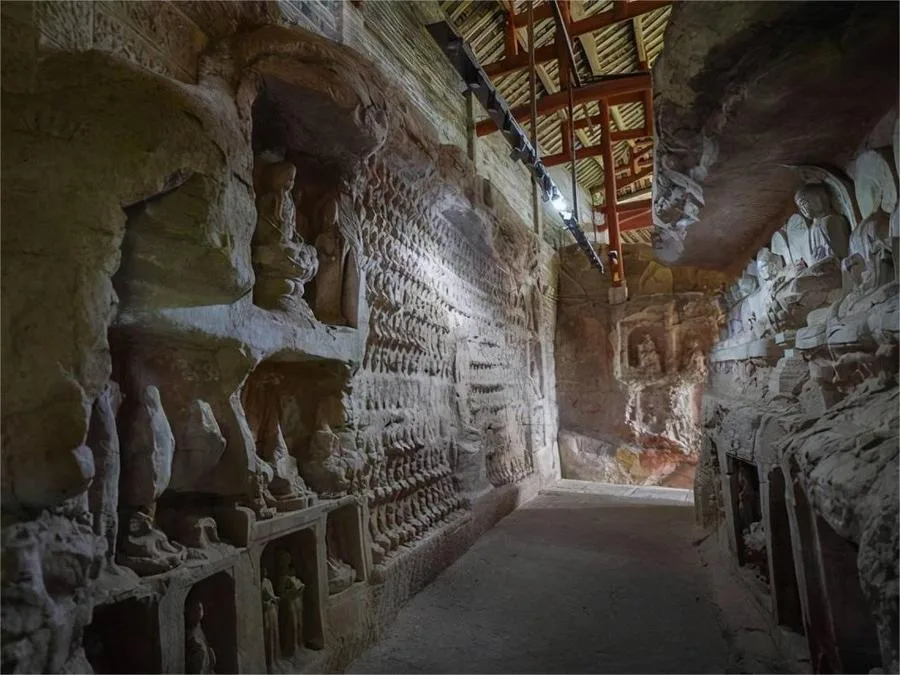
The southern section includes several notable carvings, such as those numbered 3, 5, 9, and 10, which are exemplary of late Tang period art. Carvings numbered 50 and 51, which are dated to the Qianning (894-898) and Guanghua (898-900) periods, depict figures with rich, lifelike appearances. The statues are characterized by their robust and realistic human forms.
One of the highlights in this section is the statue of Bishamonten (Vaisravana), numbered 5. This late Tang carving stands 2.5 meters tall and 0.83 meters wide. The figure faces south, exuding a powerful and majestic presence. Bishamonten is adorned with a high square crown, with flames and a circular halo surrounding his head. He is dressed in armor, with a sword at his waist, extending his right hand forward and raising his left hand. Below his feet are two yakshas. Flanking him are various attendants and followers, each depicted with unique expressions and postures. The late Tang carvings in Beishan are noted for their full and round forms, thick and solid appearance, and simple yet elegant attire, which collectively convey a sense of dynamism and fluidity.
Fowan also includes six significant steles and eight scripture pillars. Among these, the “Stele of Wei Junjing” from the Tang Dynasty is particularly valuable for the study of ancient Chinese calligraphy. The inscriptions retain the names of ancient artisans, such as Yingshuan Xu’an and members of the Fu family, including Fu Yuanjun and Fu Shining, providing crucial insights into the craftsmen’s contributions to this historical site.
Northern Section of Fowan Site

The northern section of Fowan is home to some of the finest examples of Beishan Rock Carvings. One of the most remarkable niches is the Rotating Sutra Repository (No. 136), measuring 4.05 meters in height, 4.1 meters in width, and 6.79 meters in depth. This niche features a flat-topped, square design with an octagonal coiled dragon pillar in the center. The lower tier represents Mount Sumeru, adorned with intertwined dragons whose heads and tails meet at the front.
The central wall of this niche features a seated statue of Shakyamuni Buddha, with his hands positioned in front of his chest in a teaching gesture. Flanking him are the Bodhisattvas Guanyin and Mahasthamaprapta. The southern wall depicts Manjushri, the Wish-fulfilling Guanyin, and the Cintamanicakra Guanyin, while the northern wall features Samantabhadra, the Sun and Moon Guanyin, and the Rosary Guanyin.
Within the cave walls are five inscriptions from the Southern Song Dynasty, dated between 1142 and 1146. Other notable dated carvings include those from the Northern Song Dynasty, such as those from the Xianping (998-1004) and Jingkang (1126-1127) periods, and the Southern Song Dynasty’s Jianyan period (1127-1130). Exemplary Song Dynasty carvings in this section include the Rosary Guanyin (No. 125), the Water-moon Guanyin (No. 113), the Peacock King (No. 155), and the Ksitigarbha Transformation (No. 117).
Baodingshan Rock Carvings

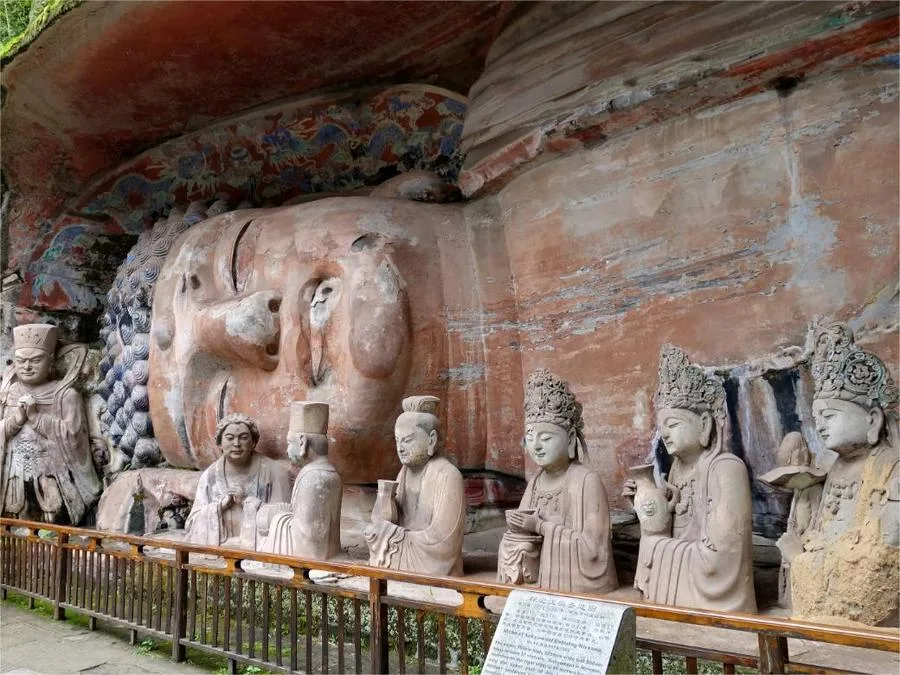
The Baodingshan Rock Carvings are located in Baoding Town, Dazu District, Chongqing. These carvings are primarily centered around Dafowan and also include Xiaofowan, Guangdasan, Longtan, and Songlinpo. The carvings were created over a period of more than 70 years, from the sixth year of the Chunxi era to the ninth year of the Chunyou era in the Southern Song Dynasty (1179–1249).
The sculptures are distributed across the eastern, southern, and northern cliff faces and include 31 large-scale carvings and 17 inscriptions. The carved cliff face covers approximately 3,600 square meters. With the exception of Pilu Cave and Yuanjue Cave, all the sculptures are large-scale cliff carvings.
Shengshou Temple
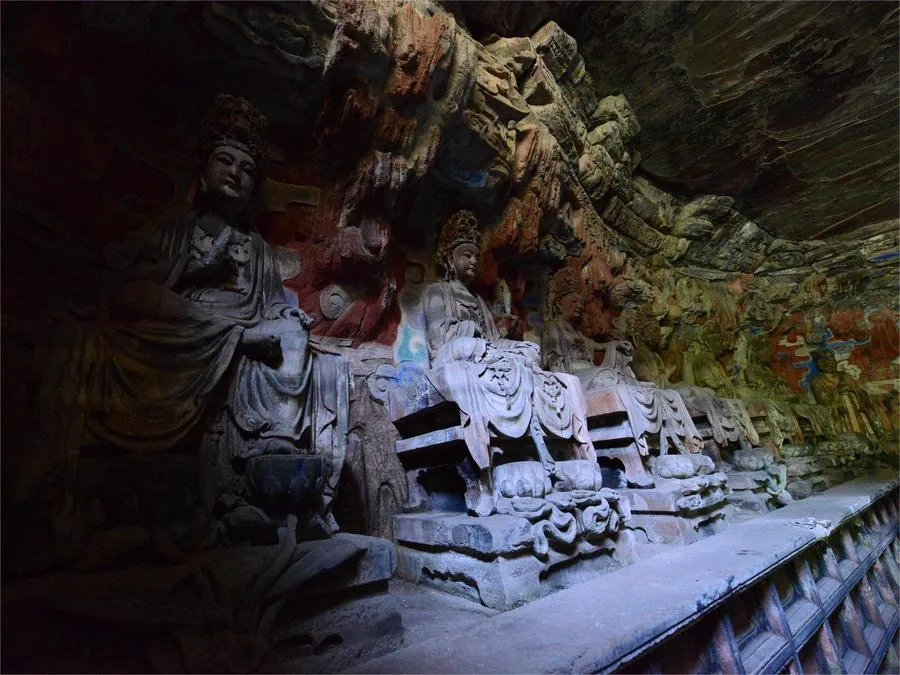
Shengshou Temple is located to the right rear of Dafowan in Baodingshan. It was originally named “Five Buddha Cliff” and was established by the prominent Southern Song monk Zhao Zhifeng in the fifth year of the Chunxi era (1178). The temple complex covers an area of 5,000 square meters and was built into the mountainside, showcasing a grand and majestic architectural style. The temple suffered damage during the Yuan and Ming dynasties but was rebuilt twice during the Ming and Qing dynasties.
Today, the main structures of Shengshou Temple that remain are the Mountain Gate, Hall of Heavenly Kings, Hall of Emperor Shakra, Mahavira Hall, Hall of the Three Buddhas, Hall of Burning Lamps, and the Vimalakirti Hall. These seven halls, covering a total construction area of 1,631.68 square meters, were reconstructed during the Qing dynasty. Each hall has its own unique significance and contributes to the overall spiritual and historical value of the site.
Guangda Temple

Guangda Temple is located about one li (approximately 500 meters) from Shengshou Temple. The carvings at Guangda Temple are situated on the cliffs outside the temple and feature three half-body statues. These statues are characterized by their spiral hair knots and crowns, exemplifying the intricate artistry of the era.
Approximately 2 kilometers from Shengshou Temple lies the Longtan Cliff Carvings. The most notable of these is a seated figure at the base of the cliff, depicted with a hat and a tied belt, gazing upwards. The cliff also features images of the bodhisattva Guanyin and other figures, along with two incomplete inscriptions.
Dafowan Rock Carving Site
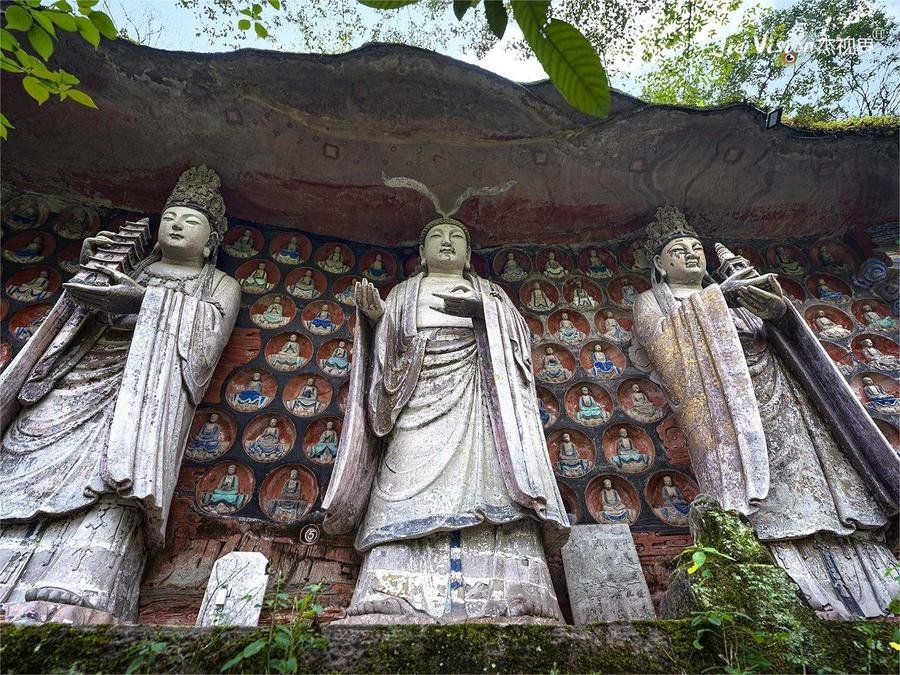
Dafowan, located to the lower left of Shengshou Temple, is a U-shaped cliff bay. This site features a continuous expanse of carvings that span approximately 500 meters in length and range from 8 to 25 meters in height. The carvings are situated on the eastern, southern, and northern cliff faces, with a total of 31 numbered sections. The reliefs and sculptures in Dafowan are predominantly esoteric Buddhist (Vajrayana) in nature and are considered exemplary works of Song dynasty stone carvings.
- Protective Deities and Six Realms of Rebirth: The carvings begin with images of protective deities and a depiction of the Six Realms of Rebirth, illustrating the Buddhist cosmology of samsara (the cycle of birth and rebirth).
- Vast Treasure Pavilion and Huayan Triad: Following this, the Vast Treasure Pavilion and the Huayan Triad (Vairocana Buddha and two attendant bodhisattvas) are depicted, showcasing the grand and intricate artistry of the period.
- Avalokiteshvara (Thousand-Armed Guanyin): One of the most striking carvings is the Thousand-Armed Guanyin, an icon of compassion, depicted with intricate detail and a multitude of arms symbolizing infinite ability to help sentient beings.
- Scenes from Buddha’s Life: Carvings depicting key moments from the life of Shakyamuni Buddha, such as his birth (the Nine Dragons Bathing the Prince), enlightenment, and parinirvana (nirvana after death), are also prominent.
- Peacock King Sutra and Other Sutra Illustrations: Illustrations from the Peacock King Sutra, Vimalakirti Sutra, and other Buddhist scriptures are meticulously carved, each scene rich with narrative detail and iconographic elements.
- Vairochana Cave and Parental Gratitude Sutra: The Vairochana Cave and scenes from the Parental Gratitude Sutra illustrate the filial piety theme prevalent in Chinese Buddhism.
- Hell Scenes and Moral Lessons: Hell scenes and moral lessons depicted in the Hell Transformation scene and other carvings highlight the didactic purpose of these artworks.
- Other Significant Depictions: The cliff faces also feature carvings of the Ten Kings of Hell, depictions of Daoist deities, and various narrative scenes that blend religious and secular themes.
Each carving is accompanied by inscriptions, sutras, hymns, and poetry, providing rich textual context to the visual depictions. No two niches are identical, showcasing the diversity and richness of the carvings.
Xiaofowan Rock Carving Site
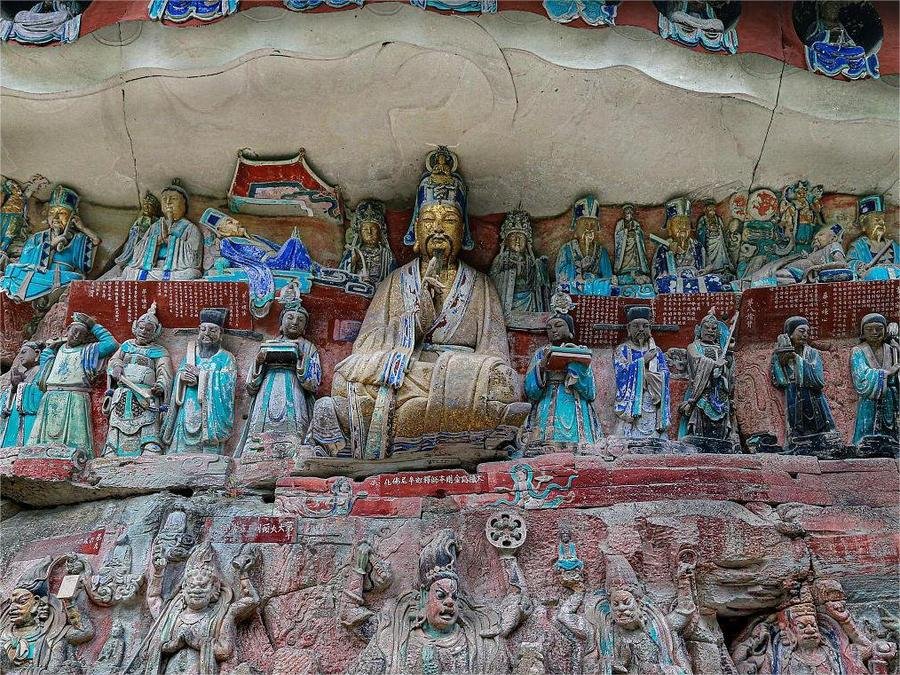
Located to the left of Shengshou Temple, Xiaofowan contains over 2,000 statues. Highlights of this site include:
- Parental Gratitude Sutra: Carvings here elaborate on the theme of parental gratitude, emphasizing filial piety and moral teachings.
- Ten Kings of Hell and Hell Transformations: Similar to Dafowan, Xiaofowan also features detailed depictions of the Ten Kings of Hell and various hell scenes.
- Vajrayana Figures and Reliefs: The site includes numerous esoteric Buddhist figures and intricate reliefs that are smaller in scale but equally detailed.
- Piluzan Tower: In front of Piluzan, there is a three-tiered square stone pagoda, with the upper two tiers depicting various Buddhas and an image of Zhao Zhifeng, while the lower tier is inscribed with numerous scriptures, hence its name “Scripture Tower.”
- Tang and Song Dynasty Stele: The area also includes a Song dynasty stele inscribed with the “Biography of Tang Liu Benzun,” with partially legible characters, reportedly re-inscribed by Zhao Zhifeng.
Adjacent to both Dafowan and Xiaofowan are notable structures like the Shakyamuni True Relic Pagoda and the Dharma Wheel Pagoda, with additional scattered carvings in the surrounding areas. These sites, rich with cultural and religious significance, showcase the artistic achievements and spiritual devotion of the Song dynasty period.
Nanshan Rock Carvings
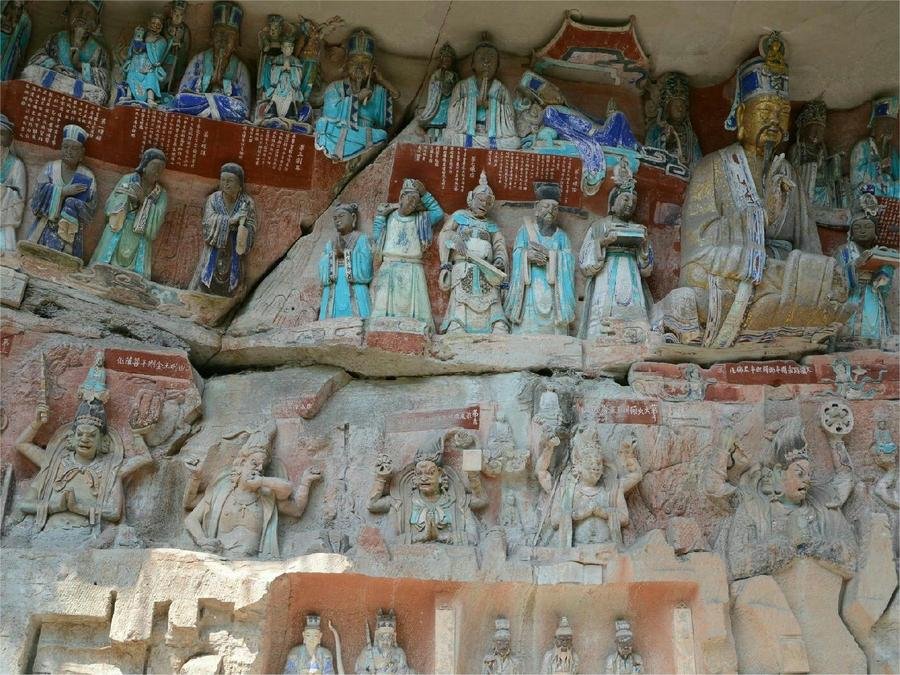
Nanshan, formerly known as Guanghua Mountain, is located 2 kilometers south of the urban area of Dazu District in Chongqing Municipality. Carved during the Southern Song Dynasty (1131-1162 AD), with continued carving during the Ming Dynasty and supplemented with numerous inscriptions from the Qing Dynasty to the Republic of China era, Nanshan Rock Carvings are a testament to centuries of cultural and religious significance. As a Taoist grotto, it comprises six grotto niches, with prominent ones being the “Three Pure Ones Grotto,” “Three Saints Mothers Grotto,” and “Dragon Grotto.” Notably, during the Ming Zhengde era, the “True Martial Ancestor Grotto” was also carved.
The “Three Pure Ones Grotto” stands as the epitome of the cliff carvings in Nanshan. Each niche features a central niche with sculptures of the Pure Jade, Supreme Pure, and Upper Pure, accompanied by depictions of the Six Daoist Celestial Lords flanking them. The walls of the grotto are adorned with 220 sculptures of celestial beings. Overall, there are approximately 500 sculptures in the area, showcasing a rich variety of divine figures from Taoist mythology.
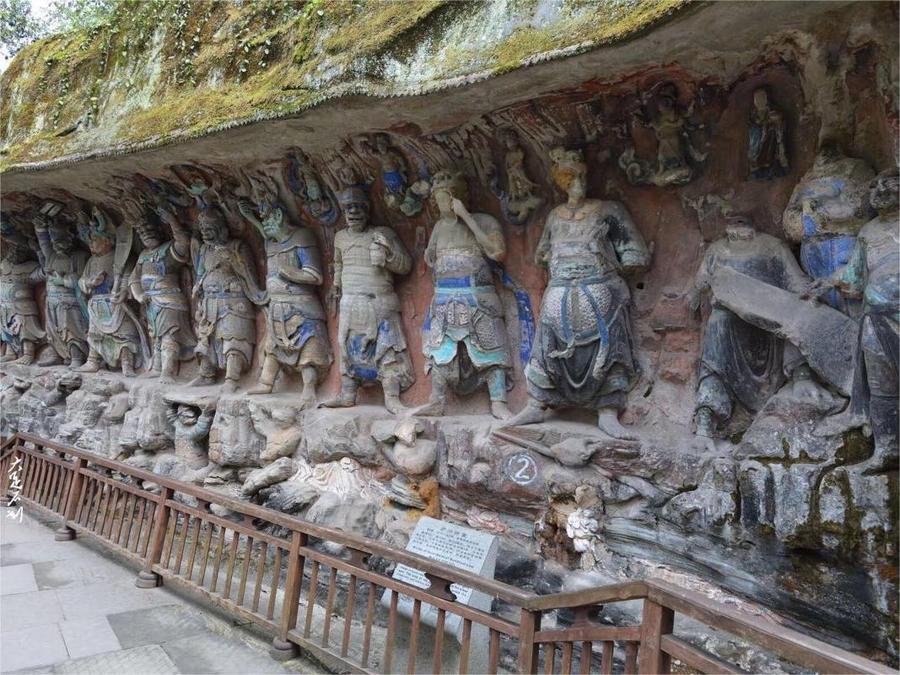
Leading to the cliff carvings area, there is the Yu Huang Temple, which currently houses ancient structures such as the front hall, Three Pure Ones Hall, and Taiqing Pavilion, most of which were either relocated or reconstructed in the 1990s. The original Laojun Pavilion, which once housed statues of the Twelve Disciples, collapsed during the Republic of China era.
The content of the Nanshan cliff carvings is diverse, vividly reflecting the pantheon of Taoist deities during the Song Dynasty, serving as invaluable visual materials for the study of Taoist history.
In addition to the sculptures, there are 28 inscriptions at Nanshan. Among them, the inscription of “Farewell to Prefect Wang Mengying by He Guangzhen” from the tenth year of the Chunyou era of the Southern Song Dynasty (1250 AD) records the basic social and political history of eastern Sichuan in the mid-thirteenth century after suffering from Mongol invasions, preserving many valuable first-hand historical materials.
Shizhuanshan Rock Carvings
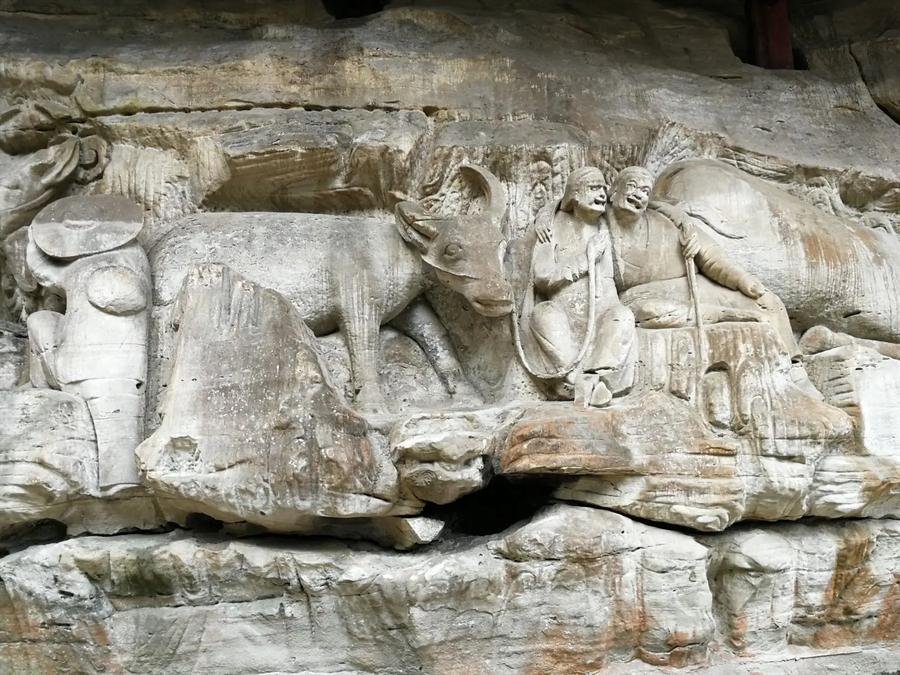
Located in Fohui Village, Sanqu Town, Dazu District, Chongqing Municipality, the Shizhuanshan Rock Carvings represent a unique amalgamation of Confucianism, Taoism, and Buddhism, carved between the fifth year of the Yuanfeng era to the third year of the Shaosheng era of the Northern Song Dynasty (1082-1096 AD). Financed by Yan Xun and executed by craftsmen led by Wen Shi, these carvings constitute a remarkable collection of religious and philosophical imagery, encompassing over 500 sculptures within nine grottoes.
Among the notable sculptures are representations of various deities and figures, including “Guanyin Bodhisattva,” “Master Zhi Gong,” “Manjusri Bodhisattva,” “Ksitigarbha Bodhisattva and the Ten Kings,” and depictions symbolizing the unity of Confucianism, Taoism, and Buddhism. Particularly rare are the “Three Teachings” sculptures, such as those found in the “King Wen Dang,” “Three Buddhas Niche,” and “Laozi Niche.” Additionally, the presence of sculptures portraying Confucius and his disciples adds a unique dimension to the site.

Historical inscriptions and carvings from the Song Dynasty confirm the timeframe of the creation of the Shizhuanshan Rock Carvings, spanning from the fifth to the third year of the Yuanfeng era (1082-1096 AD). Subsequent additions were made during the Yuan and Ming dynasties, albeit on a smaller scale. The “Yuan Xun Ji” inscription by Monk Xizhou attests to the existence of the Fohui Temple during the Yuanfeng era of the Song Dynasty, with subsequent renovations during the Ming Yongle era. Unfortunately, the tumultuous period of the Cultural Revolution led to the destruction of some carvings.
The Shizhuanshan Rock Carvings stand as a testament to the harmonious coexistence of the three major philosophical traditions in Chinese culture. Of particular significance is the sixth niche, dedicated to Confucius and his ten disciples. The central wall features a seated figure of Confucius, flanked by carvings of his ten main disciples, a rare depiction within rock carvings. The seventh niche houses sculptures representing the three manifestations of the Buddha, symbolizing his tripartite nature. In the eighth niche, the central figure of Laozi, the founder of Taoism, is surrounded by seven statues on each side representing immortals and masters, illustrating the depth of Taoist philosophy and mythology.
Shimenshan Rock Carvings

Located on Shimenshan Mountain in Shima Town, Dazu District, Chongqing Municipality, the Shimenshan Rock Carvings represent a harmonious fusion of Buddhist, Taoist, and Confucian iconography, constituting a significant part of the Dazu Rock Carvings. Spanning a length of 71.8 meters with a height ranging from 3.4 to 5 meters, the carvings are designated as site number 16, comprising 12 grottoes and over 400 sculptures. Additionally, there are preserved inscriptions documenting 20 sculptures, eight stone tablets, eight records of restoration efforts, and the names of craftsmen such as Wen Weiyi, Wen Judao, and Jian Zhongjin.
The Shimenshan Rock Carvings form a distinctive site where Buddhist and Taoist imagery coexist, with a notable emphasis on Taoist representations. The carvings feature a diverse array of subjects and themes, with Taoist grottoes represented by numbers 2, 7, 11, and 13, showcasing deities such as the Jade Emperor, the Thousand-Mile Eyes, the Ears of the Wind, the Five Sacred Emperors, Bingling, the Mountain King, and the Earth Mother. Meanwhile, Buddhist grottoes, including numbers 1, 3, 6, 8, and 9, feature figures such as the Medicine Buddha, Shakyamuni Buddha, Guanyin Bodhisattva, the Peacock King, and Ke Li Di Mu.
The Shimenshan Rock Carvings depict a myriad of divine and celestial beings coexisting within a single area, each intricately carved with exquisite detail, showcasing remarkable craftsmanship. As an integral component of the Dazu Rock Carvings, the Shimenshan site provides valuable insights for the study of religion, history, and art in the southwestern region of China. Moreover, it serves as an invaluable resource for exploring the integration of Confucianism, Buddhism, and Taoism, offering a glimpse into the rich tapestry of religious and cultural heritage in China.
Vlog about Dazu Rock Carvings
History of Dazu Rock Carvings
The origins of rock carving in China trace back to ancient India and were introduced to China in the 3rd century AD. The art flourished in two major peaks during the 5th and 7th centuries (Wei, Jin, and Tang dynasties) in Northern China before declining in the mid-8th century. Amidst this decline, the Dazu Rock Carvings emerged prominently in the late 9th century and continued to be developed until the mid-13th century, thereby extending the tradition of Chinese rock art for over 400 years. Subsequently, no large-scale rock carvings were initiated elsewhere in China, marking the Dazu Rock Carvings as the last monumental achievement in the history of Chinese cave art.
Tang Dynasty Beginnings
The carving of the Dazu Rock Carvings began during the Tang Dynasty, specifically in the Yonghui period (650-655 AD), with the earliest carvings appearing in Jianshanzi. Over the next 200 years, additional sites like Shengshui Temple saw the creation of more carvings. The significant development occurred in 892 AD, during the reign of Emperor Zhaozong, when Wei Junjing, the military governor of Changzhou, established Yongchang Village and initiated the construction of the North Mountain (Beishan) carvings, including the Northern Heavenly Kings and the Thousand-Hand Guanyin.
During the Five Dynasties and Ten Kingdoms period (907-965 AD), the carvings predominantly concentrated in Beishan. These works are characterized by their delicate and varied forms, showcasing a shift towards more elaborate and ornate designs.
Northern Song Dynasty Flourishing
In the early Northern Song period, the focus in Dazu shifted towards the creation of round sculptures within temple precincts. From 965 to 1077 AD, cliffside carvings were paused, and instead, numerous free-standing statues were produced. Notable examples include the statues at Dazhong Temple, Shibi Temple, and Yanen Temple. By the 1980s, over 100 dated Buddhist sculptures from this period were unearthed at Dazhong Temple alone.
The late Northern Song to early Southern Song period (1078-1173 AD) witnessed a resurgence in cliffside carvings. This era saw the creation of 32 distinct Buddhist, Daoist, and Confucian sites. The period’s highlight was the carving of Shizhuanshan, which incorporated the “Three Teachings” of Buddhism, Daoism, and Confucianism, initiated by the local landowner Yan Xun in 1082. Additionally, significant sites like Nanshan, Shimenshan, and the Duobao Pagoda at Beishan were completed during this time.
Southern Song Dynasty Revival
In the early Southern Song period, the carving activities in Dazu reached their zenith. The Beishan Wheel Sutra Cave, renowned for its exquisite statues, epitomizes this period’s artistic excellence. The era also witnessed an intricate blending of Buddhist, Daoist, and Confucian themes, reflecting the integration of these three philosophies into the everyday lives of the local populace.
The apex of Dazu’s carvings occurred between 1174 and 1252 AD, under the leadership of the eminent monk Zhao Zhifeng. His efforts culminated in the construction of nearly 10,000 statues at Baoding Mountain, establishing a major site for Esoteric Buddhism in China and representing the pinnacle of Dazu Rock Carvings.
Decline and Legacy
During the Ming and Qing dynasties (1368-1912 AD), the tradition of rock carving continued in Dazu, albeit on a reduced scale. Approximately 39 new sites, including Qianfoyan and Guangming Hall, were developed during this period. While some works from this era exhibit notable craftsmanship, they generally lack the scale and artistic prowess of earlier periods, with a greater focus on secular themes.
Useful Tips Summarized from Reviews
Dress Warmly: It’s colder in the mountains compared to the urban areas, so layering up is advisable.
Best Route: The recommended route is to visit Baodingshan Rock Carvings first, then the museum, and finally, the Beishan Rock Carvings. Beishan Rock Carvings are closer to the city center and allow for a less hurried experience.
Footwear: Wear shoes with good grip as the mountains can be damp, with moss covering the stairs.
Visit Both Baodingshan and Beishan: Both Baodingshan and Beishan are worth visiting. Beishan is quieter and more serene with fewer visitors. It’s recommended to visit Baodingshan first and then drive to Beishan afterward. There are parking spaces available on the mountain.
Avoid Street Food in the Scenic Area: Don’t eat at the food street within the scenic area as the food is not tasty and overpriced.



The Baoding Mountain Stone Carvings are a masterpiece and deserve to be explored slowly, taking the time to read each introduction. I originally planned to visit Beishan at night, but ended up being too late.
The Dazu Rock Carvings were much smaller than I had imagined. Also, getting from Baoding Mountain to Beishan can be quite troublesome if you don’t have a car. Especially since the road leading to the Beishan Rock Carvings is currently under construction, which limits vehicle flow and makes parking inconvenient. It’s quite a dusty walk!
Itinerary Overview: The route here is a bit repetitive (if you take the sightseeing bus, you will have to return the same way after getting off at the museum). 1️⃣ The starting point is the sightseeing bus boarding area. 2️⃣ Head forward to the Dazu Rock Carvings Museum. 3️⃣ You need to return to take the sightseeing bus to the entrance of Baoding Mountain Scenic Area. 4️⃣ Plan to spend about one to two hours browsing (the official WeChat account… Read more »
This is my second visit to the Dazu Rock Carvings, and they still appear majestic and magnificent, with intricate details. There is now a newly added museum and a dome cinema, which provides a more detailed introduction to the rock carvings.